
The St. George Utah Temple, formerly known as the St. George Temple, is a temple of the Church of Jesus Christ of Latter-day Saints in St. George, Utah. Completed in 1877, it was the third temple constructed by the church and the first in Utah, following the westward migration of members from Nauvoo, Illinois, after the death of church founder Joseph Smith.
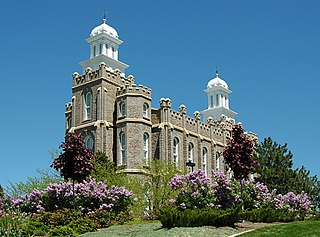
The Logan Utah Temple was completed in 1884, and is the fourth temple built by the Church of Jesus Christ of Latter-day Saints. Located in the city of Logan, Utah, it was the second temple completed in Utah, after the St. George Temple. It was built on a 9-acre (3.6 ha) plot selected by church president Brigham Young.

The Cardston Alberta Temple is a temple of the Church of Jesus Christ of Latter-day Saints in Cardston, Alberta. It was the eighth temple constructed and is the sixth still in operation. The intent to build the temple was announced on October 12, 1912, by church president Joseph F. Smith, during the church's general conference. The Cardston Alberta Temple was the first temple built in Canada and the first built outside the United States. It is one of four temples in the province of Alberta and is one of ten operated by the church in Canada. It is one of two temples built in the shape of a cross, the other being the Laie Hawaii Temple.
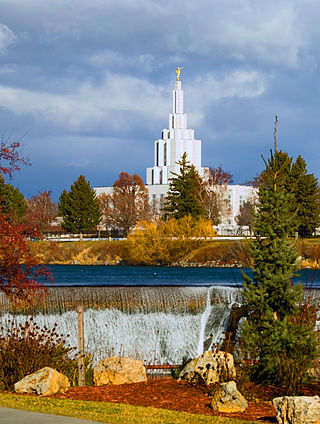
The Idaho Falls Idaho Temple is a temple of the Church of Jesus Christ of Latter-day Saints in Idaho Falls, Idaho. The intent to build the temple was announced on March 3, 1937, by church president Heber J. Grant during the church's general conference. It is the church's tenth constructed and eighth operating temple, the first built in Idaho, and the first built with a modern single-spire design.

The Oakland California Temple is a temple of the Church of Jesus Christ of Latter-day Saints in Oakland, California. Notable for its five-spire design influenced by Asian architecture, the temple stands on a hill with panoramic views of the San Francisco Bay Area. The complex, sometimes referred to as Temple Hill, includes a visitors' center, a church employment center, a materials distribution center, an auditorium, an inter-stake center, a rooftop terrace, and gardens where photoshoots for quinceañeras and other celebrations take place.

The Provo Utah Temple was a temple of the Church of Jesus Christ of Latter-day Saints located in Provo, Utah, just north of Brigham Young University (BYU). The intent to build the temple was announced on August 14, 1967, by Hugh B. Brown and N. Eldon Tanner. The church's temples are a sacred space where church members make covenants and perform ordinances for themselves and their deceased ancestors. The temple was designed by architect Emil B. Fetzer and was dedicated in 1972 as the church's seventeenth constructed and fifteenth operating temple. It was the sixth temple built in Utah, and the first in both Utah County and Provo.
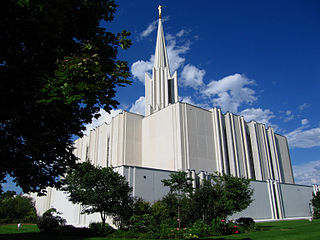
The Jordan River Utah Temple is the 20th operating temple of the Church of Jesus Christ of Latter-day Saints, located in South Jordan, Utah. The intent to build the temple was announced on February 3, 1978, by church president Spencer W. Kimball during a press conference in the Church Office Building. The temple is the first in the city of South Jordan, the fifth in Salt Lake County, and as of 2024 is one of twenty-eight in the state of Utah.

The Frankfurt Germany Temple is the 43rd constructed and 41st operating temple of the Church of Jesus Christ of Latter-day Saints. Located in the city of Friedrichsdorf, Germany, it was built with the same general architecture as the six-spire design used in the Boise, Chicago, and Dallas temples, but it was only given a single-spire.
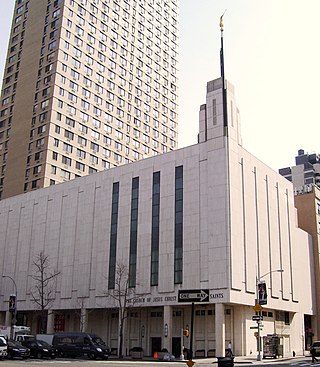
The Manhattan New York Temple is the 119th operating temple of the Church of Jesus Christ of Latter-day Saints. It is the second "high rise" LDS temple to be constructed, after the Hong Kong China Temple, and the third LDS temple converted from an existing building, the previous two being the Vernal Utah Temple and the Copenhagen Denmark Temple.

The Portland Oregon Temple is a temple of the Church of Jesus Christ of Latter-day Saints located on 7 acres (28,000 m2) of land near the intersection of Highway 217 and I-5 in Lake Oswego, Oregon. The intent to build the temple was announced on April 7, 1984 by church president Spencer W. Kimball, during the church's general conference. Dedicated in 1989, the Portland Oregon Temple was the church's first temple in Oregon and the 42nd in the church. Prior to its dedication by Gordon B. Hinckley, over 314,000 people attended the public open house.

The Mexico City Mexico Temple is the 28th constructed and 26th operating temple of the Church of Jesus Christ of Latter-day Saints.
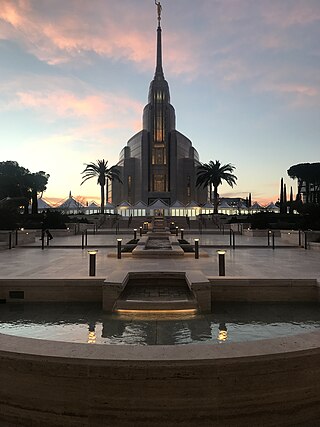
The Rome Italy Temple is a temple of the Church of Jesus Christ of Latter-day Saints in Rome, Italy. The temple serves church members in Italy, as well as Malta, Greece, Cyprus, Albania, and parts of Romania. Thomas S. Monson, the LDS Church's president, initially announced the temple in 2008, a groundbreaking took place in 2010, and the temple opened after its dedication in 2019.
The Urdaneta Philippines Temple is temple of the Church of Jesus Christ of Latter-day Saints in Urdaneta City, Pangasinan, Philippines. The intent to build the temple was announced on October 2, 2010, by church president Thomas S. Monson, during the church's general conference. The temple is the third in the Philippines, following those in Manila and Cebu City.
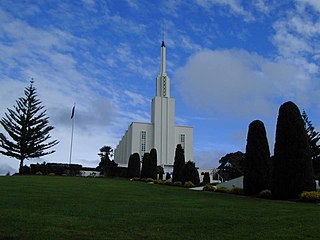
The Church of Jesus Christ of Latter-day Saints established its first New Zealand branch in 1855. It reported 117,319 members in 228 congregations in New Zealand as of 2022, making it the second largest body of LDS Church members in Oceania behind Australia. The LDS Church has one temple in New Zealand, with a second under construction and a third announced. The 2018 census recorded 54,123 individuals, or 1.2% of respondents, self-identify as belonging to the faith. 313,000 respondents objecting to answer the religion census question in 2018 were not counted in the number or percentages.
The Yigo Guam Temple is a temple of the Church of Jesus Christ of Latter-day Saints in Yigo, Guam.

The Orem Utah Temple is a temple of the Church of Jesus Christ of Latter-day Saints located in Orem, Utah. The intent to build the temple was announced on October 5, 2019, by church president Russell M. Nelson, during the church's general conference. The temple is the first in the city of Orem, the sixth in Utah County, and the 28th in the state of Utah.

The Taylorsville Utah Temple is a temple awaiting dedication of the Church of Jesus Christ of Latter-day Saints in Taylorsville, Utah. Plans to construct the temple were announced on October 5, 2019 by church president Russell M. Nelson, during the church's general conference. The temple is the first in the city of Taylorsville, the fifth in Salt Lake County, and the twenty-third in the state of Utah.
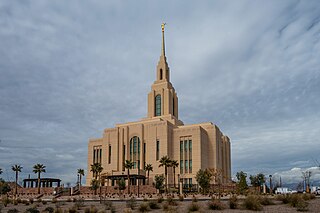
The Red Cliffs Utah Temple, originally announced as the Washington County Utah Temple, is a temple of the Church of Jesus Christ of Latter-day Saints in St. George, Utah. The intent to construct the temple was announced in October 2018 by church president Russell M. Nelson. It is the second temple in Washington County, with the St. George Utah Temple being the first, and the fourth in southern Utah.

The Church of Jesus Christ of Latter-day Saints in the Cook Islands refers to the Church of Jesus Christ of Latter-day Saints and its members in Cook Islands. The first regularly held Sunday meetings began in 1943. In 2022, there were 1,862 members in 5 congregations.





















